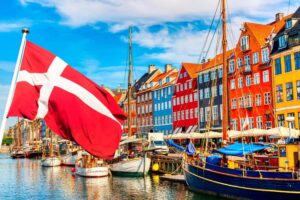This post is part of a series where I examine (which really means “read up on”) the economic and political development of the Scandinavian (or Nordic) nations from the end of WW2 to today, and summarize what I’ve learned into a blog post. Why am I doing this? Because the ongoing debate about “Scandinavian socialism” vs “Scandinavian capitalism” interests me. I’m curious for information devoid of ideological rhetoric. If you found this post via an Internet search, it probably makes sense to start with the first post in this series, the link to which is both above, and here.
Table of Contents
A summary of major economic changes, 1945 to the present
Pre WW2
First, I did not realize that Denmark was neutral during WW1, and as such, they escaped the devastating effects of the war and also (the irony is strong here) missed out on the economic growth of the post-war reconstruction. During WW1, Denmark exported goods to nations on both sides of the conflict.
WW2 German occupation
Denmark was occupied by German forces from April of 1940 to May of 1945, during which time the Germans ran the Danish central bank and doubled the money supply.
Immediate post WW2 reconstruction
As Denmark escaped the worst consequences of WW2, its post-war reconstruction was quick and Danish GDP recovered its highest prewar level in 1946.
The Marshall plan
Additionally, Denmark received support through the Marshall plan from 1948 to 1952.
Pre ECC Europe (1950 to 1957)
The precursor to the European Common Market (the ECC) was the Organization for European Economic Cooperation (OEEC).
The opening up of trade between the nations of Europe hurt the Danish manufacturing and agricultural sectors which had previously been protected through exchange control.
Denmark’s biggest trading partner at the time was Britain and when Britain devalued their currency in 1949, Denmark followed suit.
ECC Europe (1958 on)
When initial attempts to create a European-wide free trade zone failed, Denmark joined Britain in the European Free Trade Association (EFTA) created under British leadership in 1960.
When Britain was finally able to join the ECC in 1973, Denmark followed. This harmed Danish farmers due to the combination of a Europe-wide Common Agricultural Policy (CAP) and that Danish farmers had long-term loans to pay off at higher interest rates than farmers in other parts of Europe. This continued into the 1990s.
Denmark is a member of the European Union, but never accepted common citizenship, the euro currency, common foreign and defence policies, and a common policy on police and legal matters. Denmark does not use the euro to this day.
After WW2, Denmark never nationalized any industries or used fiscal policy (amount of money in circulation) as its main economic management tool.
Monetary policy (setting and hitting a target interest rate) has remained a bone of contention between Danish politicians and economists.
The welfare state (1973 on)
The sheltered sectors of the Danish economy crowded out those sectors harmed by international competition (mostly manufacturing and agriculture) which the nation responded to by increasing “public expenditures” by hiring more public employees and increased spending for health care and education, which were, and are, free for all citizens.
Today, Denmark has the second-largest Scandinavian welfare state (after Sweden) where public sector and social expenditures are about 50 percent of GDP.
The exchange rate
Denmark has adhered to a fixed exchange rate for their currency.
Immediately after WW2, the value of the Danish Krone was pegged to the UK pound. After the Bretton Woods agreement fell apart in 1972, they joined the European exchange rate cooperation, effectively pegging the value of the Krone to the German Deutschmark. After the euro was created, the value of the Krone was pegged to the euro and still is.
Denmark decided on a fixed exchange rate due to them being a small export-dependent nation. If the value of the Krone fluctuated widely compared to the currencies of their largest trading partners, the cost of their exports would too. By pegging the Krone to the value of the currency used by their largest trading partners, they stabilized the costs for nations importing from Denmark.
The structure of the government of Denmark
Denmark is a monarchy and a parliamentary democracy. The current monarch is Queen Margrethe II, who assumed the throne in 1972. Her ability to be monarch was enabled by the 1953 revision to the constitution, in which female succession was introduced. While the Queen is the official head of government, her role is largely ceremonial.
The new constitution also reduced the national assembly to one chamber (the Folketing) whose membership was increased to 179, including two seats for Greenland and two for the Faroe Islands. All members are elected on proportional representation.
Executive power is exercised by the cabinet, overseen by the prime minister, who is appointed by the monarch, after being proposed by the political party forming the government.
The last time Denmark had a majority government (where one party controls more than 50% of the seats in parliament) was in 1909.
Within the judicial branch, judges are appointed by the monarch upon recommendation of the minister of justice with the advice of the judicial appointments council.
The political climate
Denmark has a multiparty democracy with several parties occupying seats in parliament at the same time. As stated above, Denmark has not had a majority parliament since 1909, which speaks to their political plurality.
Per the Wikipedia page devoted to this topic, Denmark has 31 political parties, 13 of which currently occupy seats in the Danish Folketing and the European Parliament.
Scanning the list it seems that Danish politics would be considered “leftist” or “liberal” by American standards, although having said that, won’t most countries?
While I’m not able to find the hard data I’m interested in detailing which parties held how many seats since WW2, I am finding articles on the Internet claiming that Social Democratic parties have had significant influence in all five Scandinavian countries.
The business sector
According to the World Bank, Denmark is the easiest country in Europe in which to do business and the 4th easiest in the world, and consistently ranks among the most inviting countries for business investment, per Forbes magazine.
Trade unions
The first collective agreement in Denmark was in 1873, and the first countrywide trade union federation was founded in 1875.
In 1877 that trade union started an unemployment insurance program. So trade unions have a long history in Denmark.
Union membership is high today with 73% of employees being trade union members in 2018.
Government corruption
Transparency International, a global organization that ranks public sector corruption, ranks Denmark as tied with New Zealand as the least corrupt country on earth, with a Corruption Perceptions Index rank of 1, which is the lowest rank possible.
The legal system
The Danish court system has two tiers, district courts and high courts. Cases, start in a district court and are appealed to a high court. The highest court is the Supreme Court.
In terms of civil law, there are two special courts, the maritime and commercial high court that hears cases involving international business, patents, designs and trademarks, and the land registration court that hears cases involving rights to real property and other assets.
The banking system
The central bank is the Denmark National Bank, and on one of the central bank webpages, they talk about banks and mortgage banks. Mortgage banks are specialist banks exclusively providing loans secured by real property.
That page does weirdly talk about the banks being financial intermediaries between savers and borrowers, which is not how modern bank lending works, which you think a central bank would know.
One more very interesting thing mentioned is that Denmark classifies banks as systemically important financial institutions (SIFIs) and non-systemically important financial institutions. SIFIs are considered to be those banks that undertake activities that are of significance to the overall economy (which I suspect means are “too big to fail”).
There has been a decline in the number of banks over time. In 2000 there were 185 banks and 10 mortgage banks, whereas in 2020 they were 58 banks and 7 mortgage banks.
Danish banking regulation is per the Financial Business Act (which was updated in September of 2020) which also provides the laws for banking supervision by the Financial Supervisory Authority (FSA), an agency within the Ministry of Industry, Business, and Financial Affairs. This legislation is harmonized with EU banking regulations.
Per the International Monetary Fund, Denmark has a high level of compliance with the Basel core principles for effective banking supervision.
Government regulation of the economy
As I was reading up on government regulation of the economy within Europe, I found a focus or perspective that I thought incredibly well identifies an issue with the concept of “deregulation is good”.
It is that “deregulation” does not take into account that some rules (regulations) make sense, which others don’t.
The phrase used to promote this idea is Better Regulation.
The issue is not all regulation is bad. And bad regulations aren’t equally bad. Clearly, economies need rules, and rules mean “regulation”. So, shouldn’t the focus be on what regulations do and don’t make sense? So it was interesting to see an acknowledgment that “regulatory quality” matters. Of course, how they determine quality also matters.
Taxation
As in most modern countries, taxes in Denmark are complex, perhaps excessively so, but that’s just my opinion.
This chart compares federal tax revenue between Denmark and the average of all OECD countries, which includes the USA.

As you can see, Denmark taxes individuals MUCH more, corporations less, has no social services taxes to speak of, while consumption taxes are about the same.
Danes definitely pay more in taxes than either Americans or Canadians, but apparently, they’re happy about it as they feel they get so much in return.
The federal government of Denmark funds:
Post-secondary education, to the point of paying students a stipend, so parents don’t save for university, and students don’t graduate with massive student loan debts.
Generous parental leave (52 weeks with 32 of them being paid).
Universal healthcare, so medical bankruptcy is unknown.
Healthcare
Denmark provides healthcare to all residents, and their healthcare system covers everybody, 100 percent of the population.
CEO World website ranks Denmark as having the third-best healthcare system in the world, after South Korea and Taiwan (Canada ranks 23rd and the USA ranks 30th).
Education
Most education in Denmark is funded by the federal government and is free of charge for the student, which starts in kindergarten, and never really ends, with one in three Danish adults aged 25 to 65 taking some kind of continuing education course. As mentioned earlier, university students can be paid a monthly stipend as well as not having to pay tuition.
Natural resources
Some of the most important natural resources in Denmark are farmable land and fish. More than half of Denmark’s land is devoted to farming and animal husbandry.
They have also oil and natural gas reserves in the north sea which they’ve been harvesting since 1984. Denmark has produced more oil and gas than they use since 1997.
Wind may not sound like much of a natural resource, but in 2019, Denmark has generated just under half of its domestically produced electricity from wind power.
Direct government support and intervention
Denmark is not a laissez-faire hands-off government. The Danish government definitely intervenes in the economy, as is demonstrated by their comparatively generous welfare state, which is considered by some to be a cornerstone of the economic development of Denmark, where the government seems to work to strike a balance between the needs of Danish businesses and the needs of Danish people.
So how onerous has this been on its population?
The Heritage Foundation ranks nations as to their economic freedom. Per their 2021 index, Denmark is the 10th most economically free nation on earth, which is the highest rank among the Scandinavian countries.
For what it’s worth, Canada is ranked 9th and the USA is ranked 20th.
Foreign direct investment
Denmark has been open to foreign investment for years, although the level of foreign direct investment as a percentage of GDP has been fairly low, except for a spike in the year 2000.
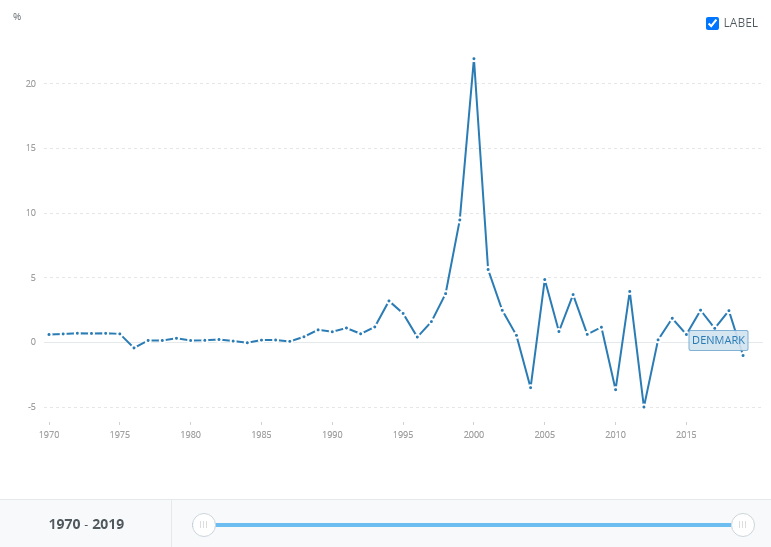
However, effective 1 September 2021 foreign direct investment in companies in Denmark is subject to a government review to ensure they do not compromise Danish national security.
Important intra and inter country partnerships
While it’s difficult to find good data on how important intra-country partnerships are, that Denmark’s government spends almost half of their GDP speaks to the importance of the role of the government in the economy, which I might add supports one of the highest standards of living in the world.
As stated earlier, the government provides universal pre-school, universal post-secondary education (university and vocational), and universal healthcare.
Additionally, about 80% of Danish workers are members of trade unions.
Based on all of the above, it would seem that partnership between business, government, higher education, and organized labour is working well in Denmark.
GDP by sector
The chart below illustrates how important government expenses and services are to the Danish economy.
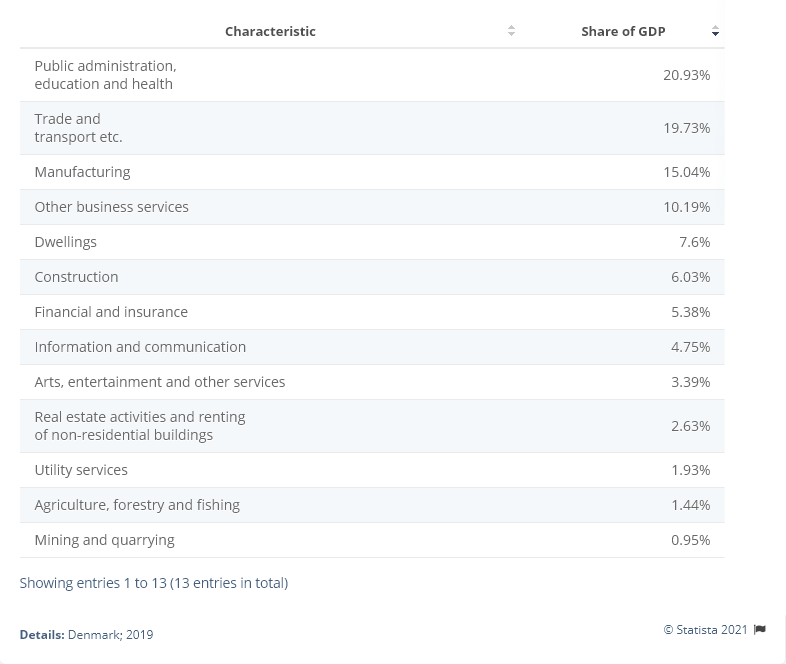
The balance of trade
Denmark has exported more than it imports consistently since 1981, with their balance of trade running at around 5% of GDP to 7% of GDP for the past 10 years.
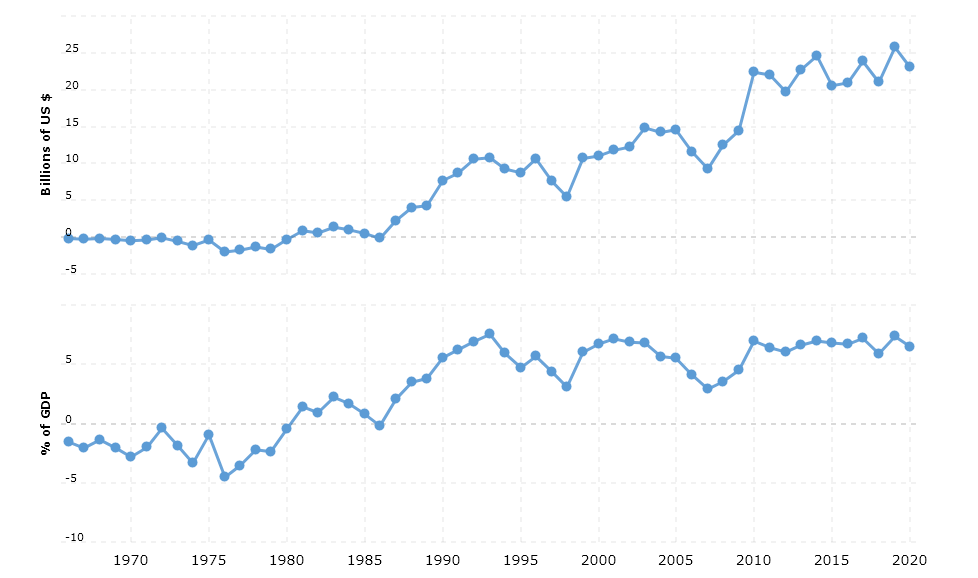
Exports by sector
The chart below shows how diverse the Danish economy is, and how many different types of products and services are exported.
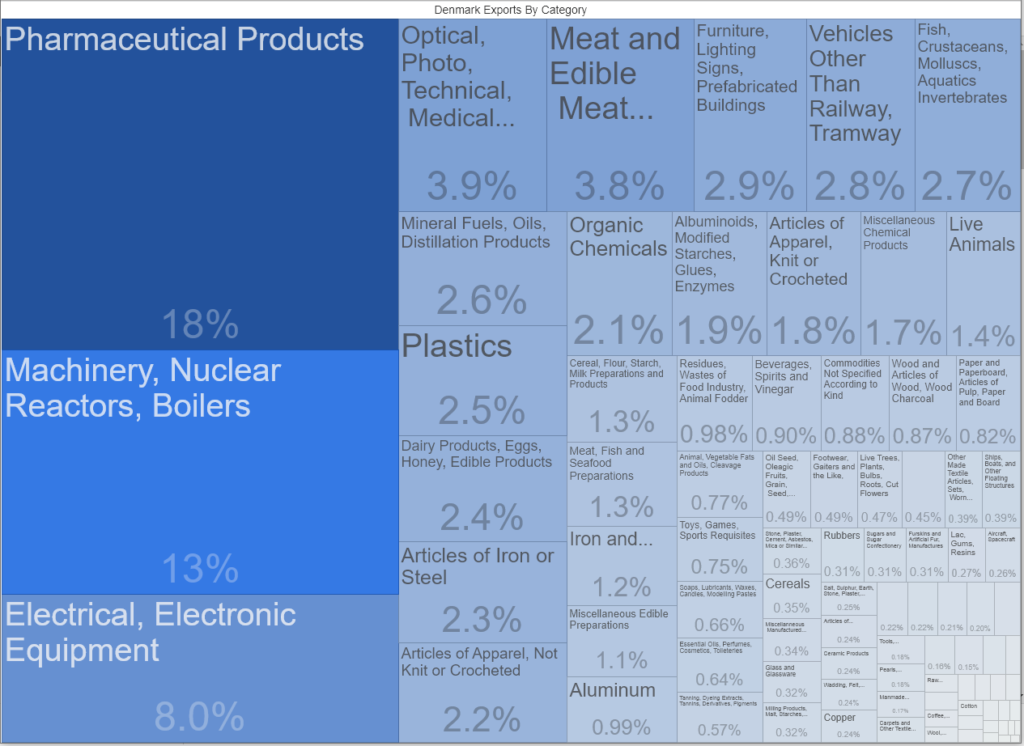
Wealth and income inequality
The most widely used measure of income distribution is the Gini index. It condenses several data points into a single number from 0 (perfect equality) to 1 (perfect inequality), although it is sometimes expressed as a number between 0 and 100.
The Gini value for Denmark for 2018 (the most recent year the World Bank website provides a value for) was 28.2, which is one of the more equal economies on earth, although since 1993 Denmark has been slowly trending towards greater inequality.
